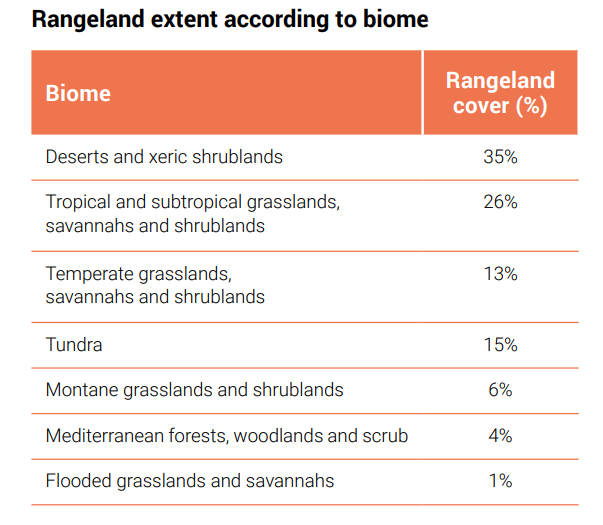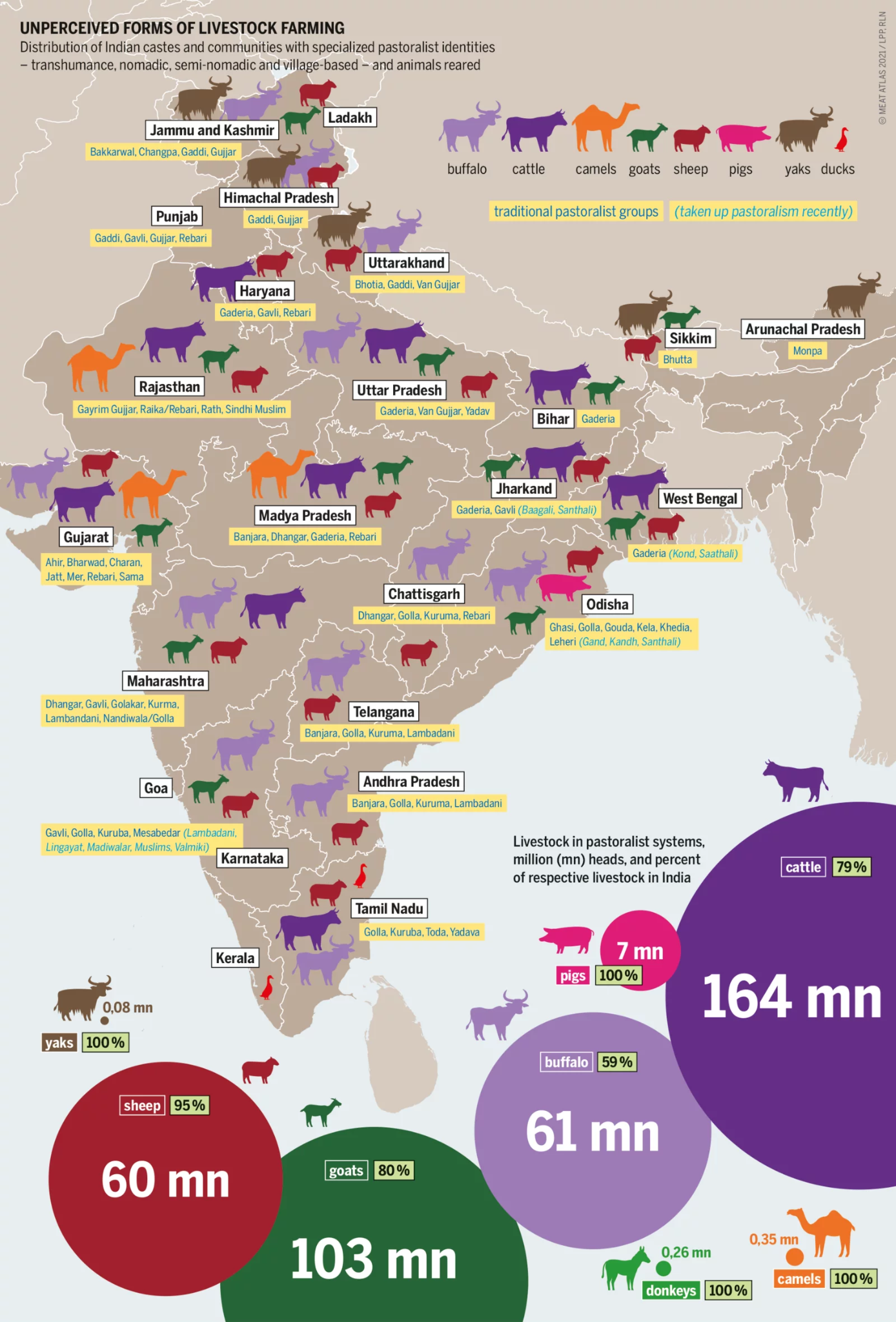Economy
Rangelands and Pastoralism
- 06 Jun 2024
- 13 min read
For Prelims: United Nations Convention to Combat Desertification Data, UN Convention to Combat Desertification (UNCCD), Land Degradation.
For Mains: United Nations Convention to Combat Desertification Data, Environmental pollution and degradation.
Why in News?
Recently a UN Convention on Combating Desertification (UNCCD) report on rangelands and pastoralists has said that millions of pastoralists in India need better recognition of their rights and access to markets.
Note
- Rangelands: Rangelands are vast natural landscapes primarily used for grazing livestock and wildlife. They are dominated by grasses, shrubs, and open-canopy trees.
- Pastoralists: Pastoralists are people who raise livestock on natural pastures. They often lead a nomadic or semi-nomadic lifestyle, moving their herds seasonally to access fresh pastures and water sources.
United Nations Convention to Combat Desertification (UNCCD)
- It was established in 1994, as a sole legally binding international agreement linking environment and development to sustainable land management.
- It addresses specifically the arid, semi-arid and dry sub-humid areas, known as the drylands, where some of the most vulnerable ecosystems and peoples can be found.
- The Convention’s 197 parties work together to improve the living conditions for people in drylands, to maintain and restore land and soil productivity, and to mitigate the effects of drought.
- The UNCCD works with the other two Rio Conventions to address the interlinked challenges of land, climate and biodiversity:
- Convention on Biological Diversity (CBD)
- United Nations Framework Convention on Climate Change (UNFCCC)
- United Nations Conference on Sustainable Development (Rio+20)
- UNCCD 2018-2030 Strategic Framework
- Conference of the Parties (COP)
What are the Key Findings of the UNCCD Report?
- State of Rangelands:
- Rangelands cover 80 million square kilometres, which is 54% of the earth surface, constituting the largest land cover/use type in the world. Of this:
- 78% occur in the drylands, mainly in the tropical and temperate latitudes
- 12% is protected rangelands worldwide.
- Around 40-45% of these lands are degraded, posing a threat to one-sixth of the world's food supply and one-third of the planet's carbon reservoir.
- Rangelands generate 16% of global food production and 70% of feed for domesticated herbivores, most significantly in Africa and South America.
- Degradation of Rangelands: Almost half of the world’s rangelands are degraded due to climate change, population growth, land-use change and growing farmlands.
- In India, rangelands occupy about 1.21 million square kilometres, from the Thar Desert to Himalayan meadows.
- As per report, less than 5% of India's grasslands are within protected areas, and the total grassland area decreased from 18 million hectares to 12 million hectares between 2005 and 2015.
- The area used for grazing is estimated at around 40% of the total land surface of India.
- Rangelands cover 80 million square kilometres, which is 54% of the earth surface, constituting the largest land cover/use type in the world. Of this:
- State of Pastoralist and Economic Contributions in India:
- Globally, an estimated 500 million pastoralists are involved in livestock production and allied occupations.
- There are around 13 million pastoralists in India, across 46 groups including Gujjars, Bakarwals, Rebaris, Raikas, Kurubas, and Maldharis.
- According to the 2020 report "Accounting for Pastoralists in India," India holds 20% of the world's livestock population and approximately 77% of the animals are raised in pastoralist systems, where they are either herded or allowed to graze on common lands.
- Pastoralists contribute to the economy through livestock rearing and milk production.
- The livestock sector contributes 4% to the national GDP and 26% to the agricultural GDP.
- The report highlighted that laws, such as the Forest Rights Act of 2006, have aided pastoralists in securing grazing rights across various states in the country.
- One notable success mentioned was the Van Gujjars obtaining grazing rights and land titles in Rajaji National Park in Uttarakhand, following a High Court judgement.
- India is currently the world's largest producer of milk, contributing 23% of global dairy production. It also leads in buffalo meat production and is the top exporter of sheep and goat meat, as reported by the Department of Animal Husbandry and Dairying. Pastoralists play a significant role in these sectors.
What is Pastoralism?
- About:
- According to the UN’s Food and Agriculture Organization (FAO), pastoralism is a livelihood system based on livestock production.
- This includes livestock rearing, dairy production, meat production, wool production, and leather production.
- Characteristics:
- Mobility: Pastoralists often move with their herds to access seasonal pastures and water sources. This mobility helps manage the sustainability of grazing resources and reduces overgrazing in any one area.
- Example: Bedouin tribes of the Arab region wander with their herds in search of water and green pastures.
- Animal Husbandry: The care and management of livestock are central to pastoralist life. This includes breeding, feeding, and protecting animals from predators and diseases.
- Cultural Practices: Pastoralist communities often have rich cultural traditions, including specific social structures, rituals, and knowledge systems related to animal husbandry and the environment.
- Economic Systems: Livestock is a crucial economic asset for pastoralists, providing food (meat, milk), materials (wool, hides), and trade goods. Some pastoralist communities also engage in trade or supplementary farming.
- Adaptation to Environment: Pastoralist practices are closely adapted to their environments, employing traditional ecological knowledge to make decisions about movement and resource use.
- Mobility: Pastoralists often move with their herds to access seasonal pastures and water sources. This mobility helps manage the sustainability of grazing resources and reduces overgrazing in any one area.
- Examples of Pastoralists Communities:
- Gujjars (Jammu and Kashmir, Himachal Pradesh, Rajasthan, and Uttar Pradesh), Raikas/Rebaris (Rajasthan and Gujarat), Gaddis (Himachal Pradesh), Bakarwals (Jammu and Kashmir), Maldharis (Gujarat), Dhangars (Maharashtra) etc.
- Maasai of East Africa: Renowned for their cattle herding in Kenya and Tanzania.
- Mongolian Nomads: Famous for their herding of horses, sheep, goats, camels, and yaks across the Mongolian steppes.
- Sami of Northern Europe: Traditionally involved in reindeer herding across Norway, Sweden, Finland, and Russia.
What are the Issues Faced by Pastoralists in India?
- Non-Recognition of Pastoral Land Rights: Many pastoral communities have traditionally used common grazing lands for generations. However, these lands often lack clear ownership or official recognition.
- This makes it difficult for pastoralists to secure access and defend their grazing routes, leading to conflicts with other land users.
- Population Growth and Land Fragmentation: India's growing population puts pressure on land resources. Land that was once available for grazing is being converted to agriculture or development projects.
- This fragmentation of grazing lands disrupts traditional migration routes and reduces the amount of food available for livestock.
- Livelihood Threats: The issues mentioned above limit access to grazing lands, impacting the ability of pastoralists to raise livestock effectively.
- Additionally, competition from commercial farms and volatile market prices for livestock products can make it difficult for them to earn a decent living.
- Sedentarization: Government policies sometimes encourage pastoralists to settle down in one place. While this may seem beneficial for providing access to social services, it can disrupt their traditional migratory patterns and reduce the efficiency of their livestock management.
- No Access to Veterinary and Medicines: Many pastoral communities, especially those who are nomadic, have limited access to veterinary care and essential medicines for their animals.
- This can lead to livestock diseases and death, further impacting their livelihoods.
- Dependence on Middle Man for Marketing: Pastoralists often lack direct access to markets and rely on middlemen to sell their livestock products. This can lead to exploitation, as middlemen may offer low prices, leaving pastoralists with little profit.
What are the Key Recommendations of UNCCD Report?
- Climate-Smart Management: Integrate strategies that address climate change into rangeland plans. This will help store more carbon while making these lands more resistant to future challenges.
- Protect Rangelands: Stop converting rangelands to other uses, especially those managed by indigenous communities. This preserves the unique variety of life these areas support.
- Conservation through Use: Design practices to conserve rangelands both inside and outside protected areas. This benefits both the land and the animals that depend on it, leading to healthier and more productive livestock production.
- Pastoralism-Based Solutions: Support traditional grazing practices and new strategies that minimise damage to rangelands caused by climate change, overgrazing, and other threats.
- Working Together: Develop flexible management systems and policies that involve everyone. This empowers local communities and ensures rangelands continue to provide benefits for society as a whole.
Read more: NGT Upholds Rights of Pastoralists in Banni Grasslands
|
Drishti Mains Question: Discuss the significance of pastoralism. Highlight the challenges faced by pastoralist communities and suggest measures to address these challenges while ensuring sustainable pastoral practices. |
UPSC Civil Services Examination Previous Year Question (PYQ)
Prelims
Q. At the national level, which ministry is the nodal agency to ensure effective implementation of the Scheduled Tribes and Other Traditional Forest Dwellers (Recognition of Forest Rights) Act, 2006? (2021)
(a) Ministry of Environment, Forest and Climate Change
(b) Ministry of Panchayati Raj
(c) Ministry of Rural Development
(d) Ministry of Tribal Affairs
Ans: (d)
Q. Consider the following statements: (2019)
- As per recent amendment to the Indian Forest Act, 1927, forest dwellers have the right to fell the bamboos grown on forest areas.
- As per the Scheduled Tribes and Other Traditional Forest Dwellers (Recognition of Forest Rights) Act, 2006, bamboo is a minor forest produce.
- The Scheduled Tribes and Other Traditional Forest Dwellers (Recognition of Forest Rights) Act, 2006 allows ownership of minor forest produce to forest dwellers.
Which of the statements given above is/are correct?
(a) 1 and 2 only
(b) 2 and 3 only
(c) 3 only
(d) 1, 2 and 3
Ans: (b)
Q. Under which Schedule of the Constitution of India can the transfer of tribal land to private parties for mining be declared null and void? (2019)
(a) Third Schedule
(b) Fifth Schedule
(c) Ninth Schedule
(d) Twelfth Schedule
Ans: (b)
Mains
Q. Livestock rearing has a big potential for providing non-farm employment and income in rural areas. Discuss suggesting suitable measures to promote this sector in India. (2015)







